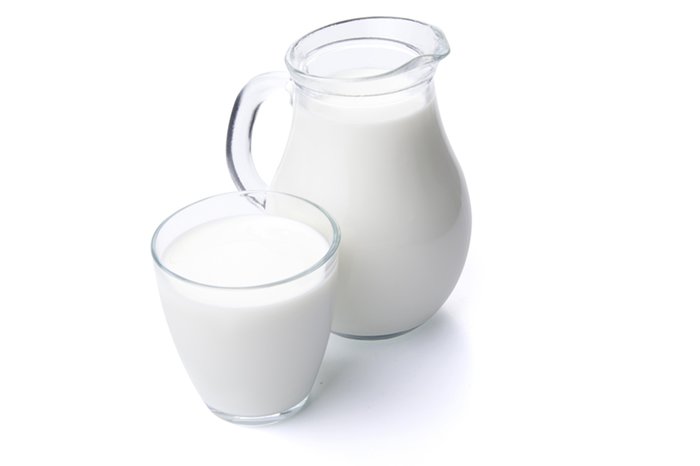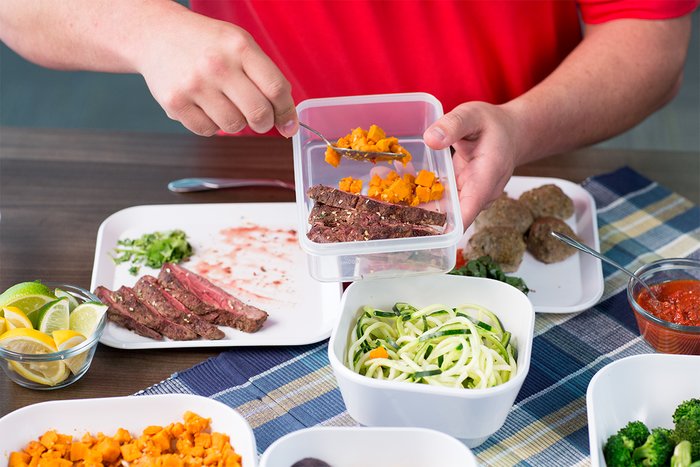Have you ever tried to lose weight and found that your progress eventually slowed to a crawl—or came to a grinding halt? Sometimes, when you're in the middle of a fat-loss program, you grow so fixated on the process that you don't step back and make sure that what you're doing makes sense.
In fact, when it comes to dieting, misinformation often reigns. Cut out fats? Wrong. Eating dairy products makes you gain weight, right? Not necessarily. The fewer calories you consume, the faster you'll shed fat? No way.
A successful fat-loss program is a combination of willpower, careful planning, and a few good tricks.
Here are 15 that just might help you get back on the path to more fat loss.
1. Implement Regular Cheat or Refeed Days
One result of dieting, especially intense dieting, is that your metabolic rate can slow down. This is because your body isn't getting the calories it needs to create energy, so it adapts by burning fewer calories each day.
If you're on a deficit diet and consuming 500 or more calories less than you need, start adding in regular cheat or refeed days to perk up your metabolism. Refeed days are when you purposely eat too many carbohydrates, while cheat days are when you indulge in a food you crave.
Either way, the point of both days is to make sure you consume more than your normal number of calories. When your body doesn't get enough energy, it goes into storage mode by conserving energy.

By boosting your metabolism, you burn more fat—and the break can help you stay psychologically sane.
2. Go Easy on the Steady-State Cardio
Steady-state cardio does very little to help you continue to burning calories in the long run. It can also can increase your appetite, making it harder to stick to your diet plan. And if you log more than five hours of steady-state cardio each week, it can interfere with your ability to lift heavy, which is the key to maintaining lean muscle mass while dieting.
"Don't make the mistake of thinking that because you spent 60 minutes on a cardio machine, you've burned a ton of calories," says Cellucor-sponsored athlete Jen Jewell.
Instead, focus on interval training, which boosts your metabolic rate for hours after a workout is finished to help preserve muscle tissue.[1]
3. Increase the Protein Content of Your Diet Plan
Adding more lean protein to your meal plan helps ensure that you don't lose muscle, which in turn helps you maintain a higher metabolic rate. But the act of eating protein burns more than its share of calories too.
I'm referring to the process of digesting protein. Protein has a higher thermic effect, so your body burns more energy breaking down protein than it does carbs or fats. Plus, protein combats hunger better than any other nutrient.
When you're trying to burn fat, consume at least 1 gram of protein per pound of body weight.
4. Don't Fear Carbohydrates, Time Them!
In this era of low-carb dieting, everyone thinks carbs are the enemy. In fact, carbs can help sustain weight loss by keeping your body's leptin levels normalized.
Yes, people who follow very low-carb diets may see rapid weight loss at the start. These same people tend to plateau faster than those who keep consuming carbs.[2]
The trick is to choose wholesome, high-fiber, low-sugar carbs and time them close to your workout so they're readily available to power you through your lifts. Make sure these good carbs are a central part of your meal plan.
5. Think Twice About Eliminating Dairy
Even people who aren't allergic to dairy often stop consuming it when they're trying to lose weight. But research shows that people who include dairy as part of their fat-loss diet show greater overall fat loss in the abdominal region.[3]

So eat up. You may want to choose lower-fat, lower-sugar options like Greek yogurt, low-fat cottage cheese, and reduced-fat hard cheese.
6. Use Fat Burners Wisely
Many people use fat burners to give them an extra edge when they're on a diet. That's fine—just don't abuse them. Any sort of stimulant-based fat burner is going to stress your body, and too much stress can lead to burnout, fatigue, or illness.
There are several types of stimulant-free fat burners on the market:
- Resveratrol: Supports healthy blood glucose levels and recovery from exercise-induced inflammation
- Carnitine: Affects the transport of fat within cells
- Capsinoids: Supports your body's ability to burn calories and fat
Non-stim fat burners are generally considered safe—just don't use them as an excuse not to exercise and eat properly.
7. Get More Sleep
Speaking of sleep, focus on getting as much as you can. You've heard it before: You need your eight hours per night. People who don't get enough sleep at night can suffer from insulin resistance, suppressed testosterone levels, and increased appetite, all of which undermine your fat-loss goals. [4-6]

8. Get Yourself a Program Buddy
Do yourself a favor and don't do your fat-loss program alone. It's simply more fun and more motivational when you work toward your goal with a friend. Whether this is a diet buddy, a gym partner, or someone else who holds you accountable as you do your program, find the support you need. It can be a game-changer.
9. Take Omega-3 Fatty Acids
If you take one supplement for your weight-loss program, make it omega-3 fatty acids. There are no sexy claims about this supplement, but make no mistake, it will help you lean out.
Take omega-3 fatty acids all the time, regardless of your goals. They help improve insulin sensitivity, support your immune system, optimize your metabolic rate, and reduce your risk of many different health conditions and diseases.
Unless you're eating salmon multiple times per week, take an omega-3 capsule with 3-6 grams every day.
10. Squat. Often.
All compound lifts are great fat burners because your body burns so many calories to do each rep.[7] Even so, nothing compares to the squat.

Not only do squats work your entire lower body and core, they also bring your upper body into the action too. People who squat heavy as part of their fat-loss program will find they're burning calories faster all day long—every day of the week.
11. Note to Self: Fat Loss Is Never Linear
To stay sane and motivated on your program, always keep in mind that fat loss is never linear. Too many people get discouraged when they lose 2 pounds one week and nothing the next.
Rather than focusing on what happens week by week, look at trends. Are you feeling leaner? Are your clothes looking looser? Do you see more muscle definition at the gym? If the answer is yes to any of those, rest assured that you're moving in the right direction.
If you go more than three weeks without any changes in your weight, cut your calories—or schedule in a refeed or cheat day.
12. Write Down Your Goals
We all have moments of weakness on our diet where we want to give up. That's where writing down your goals and sticking to them comes in.
"Establishing a strong set of achievable goals is crucial to weight loss," says Cellucor-sponsored athlete Craig Capurso. "Goals keep you on track and keep you accountable for your actions. Begin with a general goal such as, 'I want to lose 30 pounds in five months,' and then work backward to create small milestones along the way to help you attain your overall goal step by step."
13. Meal Prep, Meal Prep, Meal Prep
The saying "If you fail to prepare, you're preparing to fail" is true for nutrition. Plan what you're going to eat ahead of time, then take time during the week to prepare the meals. If you don't, chances are you'll end up eating something you shouldn't.

14. Choose the Rights Fats, and Add Them Wisely
Just as you should avoid removing all carbs from your diet entirely, avoid limiting fats too, but choose—and use—them wisely. Smart fats including nuts, seeds, olive oil, coconut oil, avocados, and fatty varieties of fish will keep your heart healthy and encourage a lower body composition. Avoid manufactured fats (trans fats) and any fats found in processed foods. Neither of these fats encourage a lean body, and they often come with health risks.
Whichever fats you choose, consume them in moderation. They are so calorie-dense, with 9 calories per gram compared to 4 per gram in carbs and proteins. that you can overshoot your calorie target before you know it. But at minimum, you should aim to consume no less than 0.3 grams of fat per pound of body weight while dieting. Many people can go higher than this if they have the calorie room to do so.
Add 5-10 grams of fat to most of your meals during the day—except around workouts. It takes your body longer to digest fats, which can make you feel sluggish.
15. Keep the Big Picture in Mind
As you go about your fat-loss program, don't let yourself get too narrow-focused, like obsessing about building six-pack abs. When you dial in one specific thing like this and don't see results, you can get very frustrated and just give up.
Keep your goals broad: Diet to gain more confidence and improve your health. Continually check in with yourself to see how you are doing in terms of reaching those goals.
"Embrace the process to progress," says Cellucor-sponsored Ron "Boss" Everline. "Quality results require an investment of time and good ol' fashioned hard work!"
References
- Gibala, M. J., & McGee, S. L. (2008). Metabolic adaptations to short-term high-intensity interval training: a little pain for a lot of gain? Exercise and Sport Sciences Reviews, 36(2), 58-63.
- Jenkins, A. B., Markovic, T. P., Fleury, A., & Campbell, L. V. (1997). Carbohydrate intake and short-term regulation of leptin in humans. Diabetologia, 40(3), 348-351.
- Zemel, M. B., Thompson, W., Milstead, A., Morris, K., & Campbell, P. (2004). Calcium and dairy acceleration of weight and fat loss during energy restriction in obese adults. Obesity, 12(4), 582-590.
- Spiegel, K., Knutson, K., Leproult, R., Tasali, E., & Van Cauter, E. (2005). Sleep loss: a novel risk factor for insulin resistance and Type 2 diabetes. Journal of Applied Physiology, 99(5), 2008-2019.
- Leproult, R., & Van Cauter, E. (2011). Effect of 1 week of sleep restriction on testosterone levels in young healthy men. Jama, 305(21), 2173-2174.
- Copinschi, G. (2005). Metabolic and endocrine effects of sleep deprivation. Essential Psychopharmacology, 6(6), 341-347.
- Bloomer, R. J. (2005). Energy cost of moderate-duration resistance and aerobic exercise. Journal of Strength and Conditioning Research, 19(4), 878.

